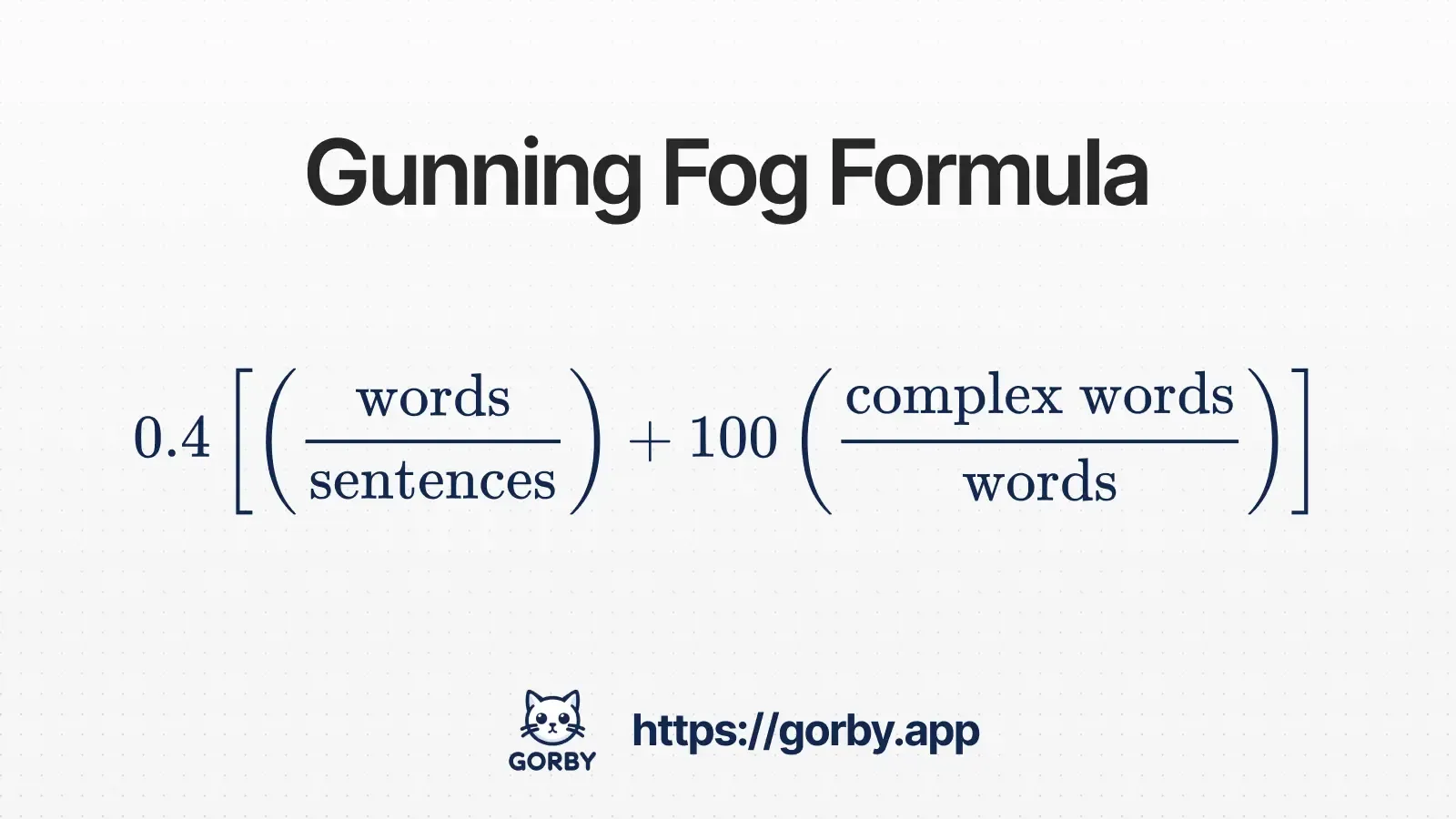Gunning Fog Index Calculator
Instantly measure your text's grade level using the Gunning Fog Index (FOG). Developed by Robert Gunning in 1952, this readability formula focuses on sentence length and word complexity to help you write clearer, more accessible content.
Understanding the Gunning Fog Index
What is the Gunning Fog Index?
The Gunning Fog Index is a powerful readability formula designed to help writers communicate more effectively. Developed by Robert Gunning in 1952, it emerged from a critical observation: many high school graduates struggled with reading not because of their abilities, but because business and technical writing was unnecessarily complex.
Unlike earlier readability formulas that were too complicated for practical use, Gunning created a straightforward tool that focuses on two key factors: sentence length and word complexity. The formula yields a number corresponding to the years of formal education needed to understand a text on first reading.
Origins and Development
In 1944, readability tools were largely unknown outside academic circles. Gunning, who had spent years in textbook publishing, recognized that newspapers and business documents often contained unnecessary "fog" - complex language that obscured meaning. This insight led him to establish the first readability consulting firm in 1944, where he worked with over 60 major newspapers and magazines to improve their writing clarity.
The Fog Index was refined through extensive real-world testing, focusing on elements that most affect reader comprehension. Gunning's approach was revolutionary: instead of creating another academic tool, he developed a practical formula that writers could use to assess and improve their work immediately.
Key Features
The Gunning Fog Index stands out for several reasons:
- Simple measurement focused on sentence length and word complexity
- Clear grade-level scoring that directly indicates reading difficulty
- Practical application for both writers and editors
- Equal effectiveness for technical and general content
Modern Applications
Today, the Fog Index remains a vital tool across various fields. Technical writers use it to ensure documentation is accessible, journalists employ it to maintain clear communication, and businesses rely on it to create effective customer communications. Its enduring relevance stems from a fundamental truth: clarity in writing is essential for effective communication.
Importantly, Gunning emphasized that the index should be used as a diagnostic tool, not a formula for writing. It helps identify potential clarity issues but should never override good judgment or creative expression. The goal is to make writing more accessible without making it simplistic.
The Gunning Fog Formula Explained

Understanding the Components
The Gunning Fog formula combines two key measurements to determine reading difficulty. Let's break down each component:
Scaling Factor (0.4)
The multiplication by 0.4 calibrates the final score to correspond with U.S. grade levels. This factor was determined through extensive research with the McCall-Crabbs reading tests, ensuring the formula's output aligns with actual reading comprehension levels.
Average Sentence Length (words/sentences)
Calculate this by dividing the total number of words by the number of sentences. This measures sentence complexity, with longer sentences generally indicating more sophisticated writing. Important note: semicolons and colons create compound sentences that should be counted as separate sentences.
Complex Word Percentage (100 × complex words/words)
Count words with three or more syllables, excluding: proper nouns (like "Washington"), familiar compound words (like "bookkeeper"), and words made three syllables by adding -ed or -es (like "created" or "trespasses"). Divide this count by total words and multiply by 100 to get the percentage of complex words.
Important Calculation Notes
- For long texts, take several 100-word samples spaced evenly through the text
- For shorter texts, analyze the entire passage as one sample
- Proper nouns are excluded from hard word counts regardless of syllable count
- Semicolons and colons create compound sentences that should be counted as separate sentences
Quick Example
Let's analyze this passage about urban gardening:
- Total words: 111
- Number of sentences: 6
- Average sentence length: 18.5 words
- Complex words: ordinary, sustainable, metropolitan, enthusiasts, cultivate, community, neighborhoods, apartment, gradually, experience, confidence, environmental, transportation, organize, fundamental, beginners, collaborative, atmosphere, neighborhood, connections, additionally, educational, sustainable (23 words)
- Complex word percentage: (23/111) × 100 = 20.72%
- Final calculation: 0.4 × (18.5 + 20.72) = 15.69
This passage scores at approximately a college junior level (15.69), primarily due to its high percentage of complex words. While the sentence length is moderate, the frequent use of multisyllabic words increases the overall complexity, making it more suitable for an advanced academic audience.
FOG Grade Level Scale
The Gunning Fog Index directly corresponds to the U.S. education grade level required to comprehend the text. Here's a comprehensive breakdown of scores and their interpretations.
| FOG Score | Grade Level | Reader Age |
|---|---|---|
| 17 | College graduate | 22+ |
| 16 | College senior | 21-22 |
| 15 | College junior | 20-21 |
| 14 | College sophomore | 19-20 |
| 13 | College freshman | 18-19 |
| 12 | High school senior | 17-18 |
| 11 | High school junior | 16-17 |
| 10 | High school sophomore | 15-16 |
| 9 | High school freshman | 14-15 |
| 8 | Eighth grade | 13-14 |
| 7 | Seventh grade | 12-13 |
| 6 | Sixth grade | 11-12 |
Interpreting FOG Scores
The ideal Fog Index score depends entirely on your target audience. While lower scores generally indicate better readability, some content requires higher complexity. Here's a practical guide for different types of content:
General Audience Content
Aim for scores between 7-8 (7th-8th grade level). This range is accessible to most readers while maintaining professional credibility. Most popular magazines and newspapers target this level.
Business Communications
Keep scores between 10-12 for business documents. This range ensures professionalism while maintaining clarity. Anything higher risks reducing comprehension and engagement.
Technical Documentation
Scores between 10-14 are acceptable, reflecting the complex nature of technical subjects. However, strive to break down complex ideas into clearer explanations when possible.
Academic Writing
Scores of 15-17 are common and often necessary, reflecting the sophisticated concepts and vocabulary required for academic journals and advanced research papers.
📝 Pro Tip
When in doubt, remember Gunning's advice: the average adult reader is comfortable at around the 8th-grade level (FOG score of 8). Unless your content specifically requires higher complexity, aiming for this level ensures maximum accessibility while maintaining professional standards.
Gunning Fog Index vs other readability metrics
While several readability formulas exist, each offers unique advantages for specific use cases. Here's how the Gunning Fog Index compares to other popular metrics:
Automated Readability Index
Uses character count instead of syllables. While ARI focuses on raw character counts, Gunning Fog specifically identifies complex words, making it more intuitive for writers to understand which specific words might be making their text difficult.
Flesch-Kincaid Grade Level
Counts all syllables, while Gunning Fog focuses specifically on words with three or more syllables. This targeted approach helps writers identify particularly challenging vocabulary that might affect readability, rather than analyzing every word's complexity.
Dale-Chall Readability Formula
Uses a predefined list of "easy" words, while Gunning Fog uses syllable count with specific exceptions. This makes Fog more flexible and easier to apply across different fields, as it doesn't require maintaining or referencing a word list.
SMOG Index
Requires a minimum of 30 sentences and counts polysyllabic words. Gunning Fog can provide reliable results with shorter texts and includes important exceptions for common polysyllabic words, making it more practical for everyday use.
Key Advantages of Gunning Fog
- Practical focus on identifying specific challenging words
- Built-in exceptions for common polysyllabic words
- Direct correlation with U.S. grade levels
- Easy to apply manually or with automated tools
Tips to Improve Your FOG Score
Word Choice
- • Replace complex words with simpler alternatives when possible
- • Be mindful of words with three or more syllables
- • Use technical terms only when necessary
- • Choose familiar words over obscure ones
Sentence Structure
- • Keep most sentences under 20 words
- • Break compound sentences into simpler ones
- • Vary sentence length for better flow
- • Use precise punctuation to clarify meaning
Organization
- • Start with key information
- • Use clear paragraph breaks
- • Include descriptive headings
- • Break complex lists into bullet points
Review Process
- • Read your text aloud to catch complexity
- • Check FOG score throughout writing
- • Get feedback from target audience
- • Review specifically for three-syllable words
Important Note: As Gunning himself emphasized, this formula should guide your writing, not control it. The goal is clear communication, not artificially simple text. Sometimes a complex word or longer sentence is exactly what you need - just make sure it serves your purpose and your audience.
Ready to Analyze Your Text?
Get instant readability insights with Gorby's text analysis tools.
Try our text analyzer to see all readability scores, including Gunning Fog Index, in one place. Check word counts, readability metrics, and improve your writing instantly.
Resources and References
The Technique of Clear Writing (1968)
Gunning's original book that introduced the Fog Index to the world. This seminal work emerged from his experience with over 60 newspapers and magazines, establishing the foundation for practical readability measurement.
Smart Language: Readers, Readability, and the Grading of Text
DuBay's comprehensive analysis of readability formulas, including detailed examination of the Gunning Fog Index's development, validation, and practical applications in modern content creation.
Gunning Fog Index - Wikipedia
An overview of the Gunning Fog Index, including its formula, historical context, and modern applications across different fields of writing and communication.
More Readability Tools
All Readability Metrics
Overview of all readability formulas and tools
Automated Readability Index (ARI)
Calculate grade level based on character count
Coleman-Liau Index
Analyze text complexity using characters per word
Dale-Chall Readability
Evaluate readability using word familiarity
Flesch Reading Ease
Measure text readability on a 100-point scale
Flesch-Kincaid Grade Level
Convert text complexity to U.S. grade levels
SMOG Index
Assess readability based on polysyllabic words
Spache Readability Formula
Evaluate early reading materials using familiar word lists
